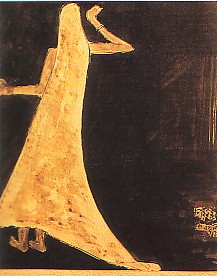Contribute
|
South Asian Art - In Memory Of Prashant Fadia Rabindranath Tagore |
Razvin Namdarian
08/31/2009
Rabindranath Tagore, a truly multifaceted personality and a one whom every Indian remembers and thanks every time he sings the Indian national anthem with pride. But other than those associated with art, few would know that Rabindranath Tagore is also considered to be the father of Indian modern art. Born in 1861, Tagore, was a genius, there is no other description for him. At the young age of eight he started writing poetry even publishing his poetry by the age of sixteen under the pseudonym of Bhanusingho or the Sun Lion. He also started writing short stories and dramas. Tagore is inextricably the part of the fabric of Bengal, there would scarcely be a home where Rabindrasangeet is not sung. He wrote over 2,300 songs in his lifetime and developed a new style of music incorporating the ‘thumri’ style of Indian classical music and also the classical ‘ragas’. Often his stories and poems formed the lyrics of his songs. He became not just India’s but Asia’s first Nobel Laureate for Literature as the author of Gitanjali which was lauded for its "profoundly sensitive, fresh and beautiful verse". Rabindranath was also painfully aware and sensitized to the social and political situation of the country. In 1890 he had attacked and criticized the anti-Indian policy of Lord Cross, then Secretary of State for India. Further, in 1905 he spearheaded the agitation against Lord Curzon's proposal to partition Bengal. Rabindranath advocated a policy of constructive non-cooperation against the British. On 16th October, when partition became a settled fact, he initiated the Rakhi-bandhan ceremony as a symbol of unity in Bengal and led a huge procession through the streets of Calcutta singing “Banglar mati, Banglar jal.†In fact, Bangladesh's national anthem Amar Shonar Bangla is also written by him. He denounced the British and rejected the knighthood and the title of ‘Sir’ that they had bestowed on him in 1915 after the 13th April 1919 massacre of Jallianwala Bagh, at Amritsar. While supporting the Indian National Movement and education in the mother tongue he set up the Visva-Bharati University. Art and painting came in rather late in Tagore’s life when he took up brush and palette at the age of 60. However, art was not alien to him, his elder brother Jyotirindranath was a proficient artist. Tagore had also encouraged his nephews - Abanindranath and Gaganendranath in their pursuit of painting and helped in founding what came to be known as the Bengal movement in Indian art. His art carried the influence of crafts of the north of Ireland, carving from the West coast of Canada and wood cuts by Max Pechstein. His colour schemes were vibrant and the compositions completely inconsistent with the typical Indian style associated with the Bengal school of art. Some critics have felt that at that age, he probably suffered from partial colour blindness and hence the peculiarities in his colour schemes. He was completely self taught and besides his actual paintings, had started on his journey into art on a subconscious level even while writing his poetry, when the notations and deletions in his works would take on artistic forms for him. He called them ‘widowed gypsies’ which seemed to be calling out to him. Many of his pen and ink drawings have text appearing as rhythmic designs woven into them. So close was the relation between his writing and his art, that often he would portray his poems as paintings. Ironically, he didn’t get immediate appreciation for his art in India, where some criticized it as art that “mars the beauty of the New Bengal School.†Tagore chose to exhibit his works abroad, and held the first exhibition in Gallerie Pigalle, Paris from 2nd – 19th May, 1930. Other exhibitions followed in Birmingham, in several European capitals and in USA. It was in 1932 that Tagore agreed to exhibit his works in India at the behest of Mukul Dey who organised the exhibition and the catalogue. In the foreword Dey paid tribute to Tagore’s works saying, “In his seventieth year, the poet's fingers are tense, and show no tremulousness. His pen and ink pictures are veritable masterpieces. The figures drawn by the poet with a single stroke of the brush vividly bring out the vitality of the inspired art of Rabindranath. His paintings have in them great movements. His portraits are the very embodiments of vitality of expression.†Though it took some time for his artistic creativity to break out of the shackles of his manuscripts, he created almost 2,500 paintings and drawings in the last 15 years of his life. They represented a new creative outlet for him, which expanded his freedom to speak of things that were kept out of his writings. Tagore initiated a new stream of thought in Indian art and inspired many. Nandalal Bose, writing on Rabindranath's pictures, said "We need to be re-educated in the fundamental values of art and can do it better than he who is creating before our very eyes forms whose vigour baffles our classifications and compels the admiration of the artist. If Rabindranath seems rough and destructive, it is because he is breaking the ground anew for us that our future flowers may be surely assured of their sap." ~ Razvin Namdarian --------------------------------------XXXXXXXXXXXX------------------------------------------------
You may also access this article through our web-site http://www.lokvani.com/

